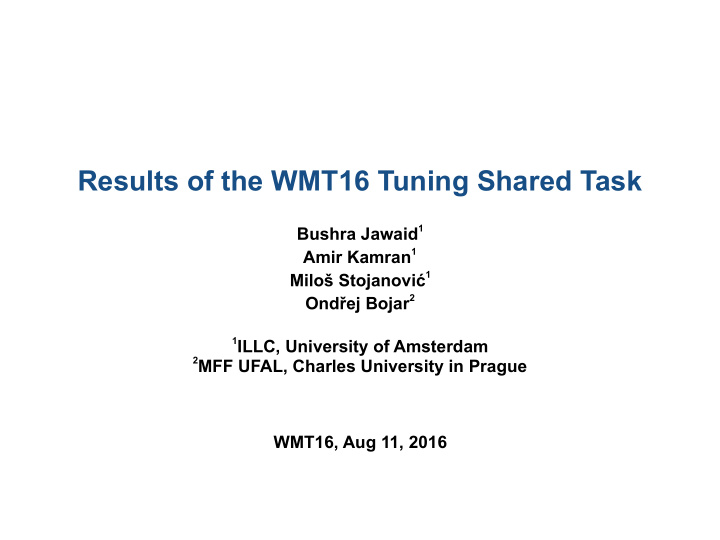



Results of the WMT16 Tuning Shared Task 1 Bushra Jawaid 1 Amir Kamran 1 Milo š Stojanovi ć 2 Ond ř ej Bojar 1 ILLC, University of Amsterdam 2 MFF UFAL, Charles University in Prague WMT16, Aug 11, 2016
Overview Summary of Tuning Task • Updates in 2016 edition • Results •
Tuning Task
Tuning Task Lexical Adequacy Fluency Length … Choice
Tuning Task Lexical Fluency Adequacy Length … Choice
Tuning Task Lexical Fluency Adequacy Length … Choice λ = ?
Tuning Task So many things to choose in tuning:
Tuning Task So many things to choose in tuning: . . . Algorithm Metric Features Data
Tuning Task So many things to choose in tuning: . . . Algorithm Metric Features Data This task is organized to explore the tuning options in a controlled settings
System for Tuning Moses phrase-based models trained both for • English-Czech and Czech-English.
System for Tuning Moses phrase-based models trained both for • English-Czech and Czech-English. This year we used large dataset to train the models and • aligned the data using fast-align.
System for Tuning Moses phrase-based models trained both for • English-Czech and Czech-English. This year we used large dataset to train the models and • aligned the data using fast-align. In constrained version 2.5K sentence pairs were available • for tuning.
System for Tuning Moses phrase-based models trained both for • English-Czech and Czech-English. This year we used large dataset to train the models and • aligned the data using fast-align. In constrained version 2.5K sentence pairs were available • for tuning. Constrained version allowed only dense features. •
System for Tuning Moses phrase-based models trained both for • English-Czech and Czech-English. This year we used large dataset to train the models and • aligned the data using fast-align. In constrained version 2.5K sentence pairs were available • for tuning. Constrained version allowed only dense features. • Any tuning algorithm or metric tuning was allowed (even • manually setting weights)
Data used for training Sentences Tokens Types Source cs en cs en cs en Europarl v7, News LM Commentary v11, 54M 206M 900M 4409M 2.1M 3.2M News Crawl Corpora (2007-15), News Discussion v1 TM CzEng 1.6 pre for 44M 501M 20.8M 1.8M 1.2M Corpora WMT16 Dev Set 2656 51K 60K 19K 13K newstest2015 Test Set 2999 56.9K 65.3K 15.1K 8.8K newstest2016
Data used for training Language Model Translation 210M Model 50M 158M 38M 105M 25M 13M 53M 0M 2015 2016 0M 2015 2016 2015 2016 en cs Comparison of data sizes (# of sentence pairs) 2015 vs 2016
Participants From 6 research groups we received, 4 submissions for Czech-English, 8 submissions • for English-Czech 2 Baselines • System Participant bleu-MIRA, bleu-MERT Baselines AFRL United States Air Force Research Laboratory DCU Dublin City University FJFI-PSO Czech Technical University in Prague ILLC-UvA-BEER ILLC – University of Amsterdam NRC-MEANT, NRC-NNBLEU National Research Council Canada USAAR Saarland University
Czech-English Results System Name True Skill Score BLEU BLEU-MIRA 0.114 22.73 AFRL 0.095 22.90 NRC-NNBLEU 0.090 23.10 NRC-MEANT 0.073 22.60 ILLC-UvA-BEER 22.46 0.032 BLEU-MERT 0.000 22.51
Czech-English Results System Name True Skill Score BLEU BLEU-MIRA 0.114 22.73 AFRL 0.095 22.90 NRC-NNBLEU 0.090 23.10 NRC-MEANT 0.073 22.60 ILLC-UvA-BEER 22.46 0.032 BLEU-MERT 0.000 22.51 Manual evaluation of tuning systems can draw only very • few clear division lines.
Czech-English Results System Name True Skill Score BLEU BLEU-MIRA 0.114 22.73 AFRL 0.095 22.90 NRC-NNBLEU 0.090 23.10 NRC-MEANT 0.073 22.60 ILLC-UvA-BEER 22.46 0.032 BLEU-MERT 0.000 22.51 Manual evaluation of tuning systems can draw only very • few clear division lines. KBMIRA turns out to consistently be better than MERT. •
English-Czech Results System Name True Skill Score BLEU BLEU-MIRA 0.160 15.12 ILLC-UvA-BEER 0.152 14.69 BLEU-MERT 0.151 14.93 AFRL2 0.139 14.84 AFRL1 0.136 15.02 DCU 0.134 14.34 FJFI-PSO 0.127 14.68 7.95 USAAR-HMM-MERT -0.433 0.82 USAAR-HMM-MIRA -1.133 0.20 USAAR-HMM -1.327
Comparison with main translation task 2016 2015
Comparison with main translation task 2016 2015
Conclusion The task was much larger this year. • Task attracted good participation like last year. • The quality of most submitted systems is hard to • distinguish manually. With large models, the few parameters are most likely not • powerful enough (and sadly nobody tried discriminative features) The results confirm that KBMIRA with the standard • features optimized towards BLEU should be preferred over MERT.
Recommend
More recommend